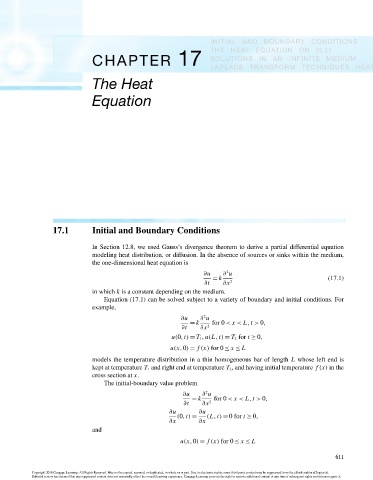Page 631 - Advanced_Engineering_Mathematics o'neil
P. 631
INITIAL AND BOUNDARY CONDITIONS
THE HEAT EQUATION ON [0, L]
CHAPTER 17 SOLUTIONS IN AN INFINITE MEDIUM
LAPLACE TRANSFORM TECHNIQUES HEAT
The Heat
Equation
17.1 Initial and Boundary Conditions
In Section 12.8, we used Gauss’s divergence theorem to derive a partial differential equation
modeling heat distribution, or diffusion. In the absence of sources or sinks within the medium,
the one-dimensional heat equation is
∂u ∂ u
2
= k (17.1)
∂t ∂x 2
in which k is a constant depending on the medium.
Equation (17.1) can be solved subject to a variety of boundary and initial conditions. For
example,
2
∂u ∂ u
= k for 0 < x < L,t > 0,
∂t ∂x 2
u(0,t) = T 1 ,u(L,t) = T 2 for t ≥ 0,
u(x,0) = f (x) for 0 ≤ x ≤ L
models the temperature distribution in a thin homogeneous bar of length L whose left end is
kept at temperature T 1 and right end at temperature T 2 , and having initial temperature f (x) in the
cross section at x.
The initial-boundary value problem
∂u ∂ u
2
= k for 0 < x < L,t > 0,
∂t ∂x 2
∂u ∂u
(0,t) = (L,t) = 0for t ≥ 0,
∂x ∂x
and
u(x,0) = f (x) for 0 ≤ x ≤ L
611
Copyright 2010 Cengage Learning. All Rights Reserved. May not be copied, scanned, or duplicated, in whole or in part. Due to electronic rights, some third party content may be suppressed from the eBook and/or eChapter(s).
Editorial review has deemed that any suppressed content does not materially affect the overall learning experience. Cengage Learning reserves the right to remove additional content at any time if subsequent rights restrictions require it.
October 14, 2010 15:25 THM/NEIL Page-611 27410_17_ch17_p611-640

